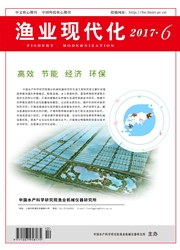

 中文摘要:
中文摘要:
为了获得复合M型人工鱼礁的流场效应,为鱼礁的结构设计提供理论依据,选取3个不同水流流速(6.7cm/s、11.0cm/s、18.0cm/s),采用粒子图像测速(PIV)技术,对复合M型人工鱼礁的二维流场进行测试。结果表明:礁体迎流面和背流面分别产生上升流和背涡流,其规模随着来流速度的增加而增大;当鱼礁圆柱孔与流向夹角为90°时所产生的上升流高度为礁高的53%~90%,背涡流面积为迎流面积的0.7—1.3倍;夹角为0。时上升流高度为礁高的33%-83%,背涡流面积为迎流面积的40%~60%;90。工况下上升流平均流速是0。工况时的1.1—2.7倍,背涡流的最大回流速度为0°时的3.0~9.0倍。鱼礁投放时采用鱼礁圆柱孔与水流流向垂直的摆放形式流态较好。
 英文摘要:
英文摘要:
In order to provide a theoretical basis for the structural design of reefs, effects of compound M artificial reef on flow field have been studied through two dimension Particle Image Veloeimetry (PIV) technology at a velocity of 6.7 cm/s, 11.0 cm/s and 18.0 em/s. The results showed that the ranges of upwelling and wake increased with the increase of water speed. The upwelling's height was 53% to 90% of the reef height and the area of back eddy was 0.7 to 1.3 times than the square of reefs facing the income current when the cylindrical hole and the flow with an angle of 90° . The upwelling's height was 33% to 83% of the reef height and the area of back eddy was 40% - 60% than the square of reefs facing the income current when the cylindrical hole and the flow with an angle of 0% The average velocity of upwelling and the maximum velocity of back eddy with an angle of 90° was 1.1 to 2.7 times and 3.0 to 9.0 times than the angle of 0°. A better flow pattern was got when the cylindrical hole was perpendicular to flow .
 同期刊论文项目
同期刊论文项目
 同项目期刊论文
同项目期刊论文
 Using a time-domian higher-order boundary element method to simulate wave and current diffraction fr
Using a time-domian higher-order boundary element method to simulate wave and current diffraction fr Identification of hydrodynamic coefficients from experiment of vortex-induced vibration of slender r
Identification of hydrodynamic coefficients from experiment of vortex-induced vibration of slender r Laboratory observations of wave evolution, modulation and blocking due to spatially varying opposing
Laboratory observations of wave evolution, modulation and blocking due to spatially varying opposing Laboratory tests of vortex-induced vibrations of a long flexible riser pipe subjected to uniform flo
Laboratory tests of vortex-induced vibrations of a long flexible riser pipe subjected to uniform flo A three-index estimator based on active thermometry and a novel monitoring system of scour under sub
A three-index estimator based on active thermometry and a novel monitoring system of scour under sub Application of Multiscale Fiber Optical Sensing Network Based on Brillouin and Fiber Bragg Grating S
Application of Multiscale Fiber Optical Sensing Network Based on Brillouin and Fiber Bragg Grating S Numerical analysis on ultimate pullout bearing capacity of drag embedment anchor based on elastic-pl
Numerical analysis on ultimate pullout bearing capacity of drag embedment anchor based on elastic-pl Scour monitoring system of subsea pipeline using distributed Brillouin optical sensors based on acti
Scour monitoring system of subsea pipeline using distributed Brillouin optical sensors based on acti 期刊信息
期刊信息
